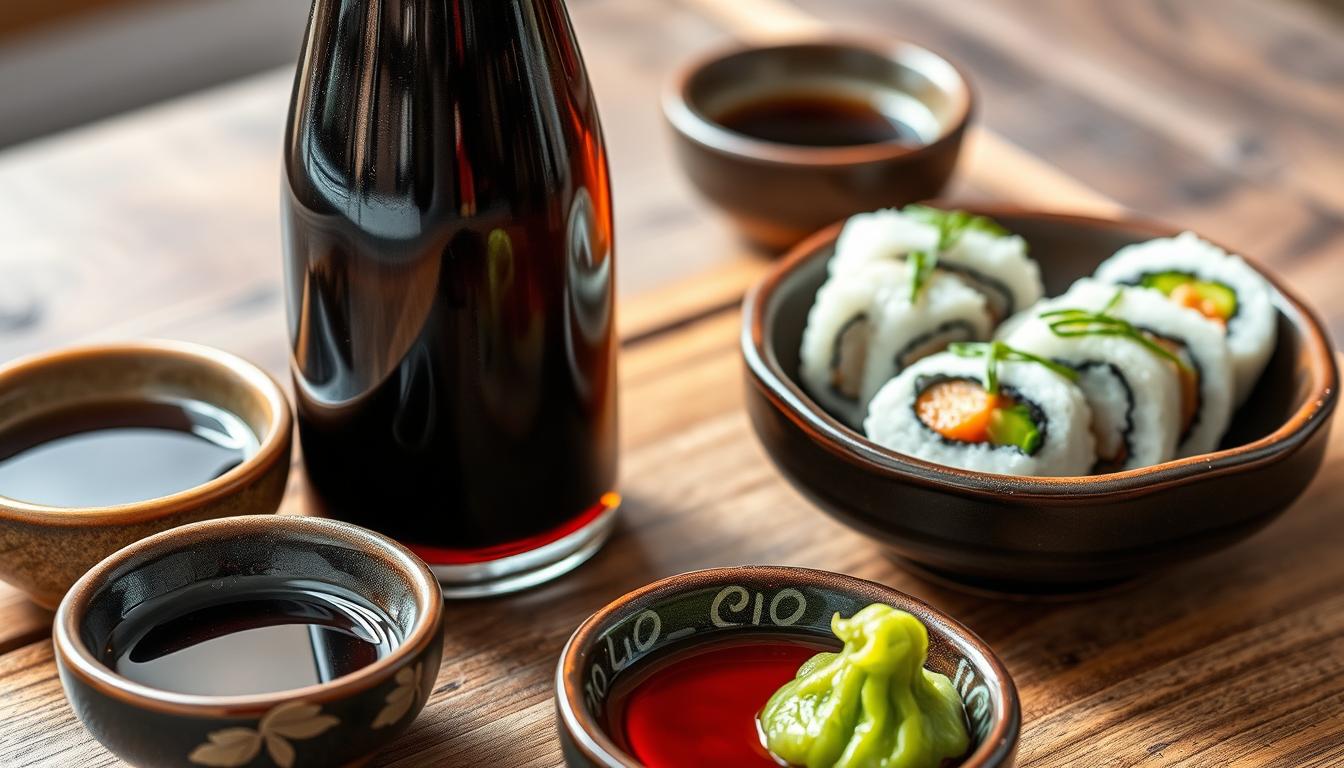Japanese soy sauce, or shoyu, is made from soybeans, wheat, salt, and water. It’s a key part of Japanese food, adding rich umami flavors. These flavors are deeply rooted in Japan’s food culture.
The making of soy sauce is traditional. It involves fermenting these ingredients in large barrels for months. This creates a complex and nuanced taste.
Soy sauce is very versatile. It’s used in many Japanese dishes, like sushi and teriyaki. It can also be used as a marinade, seasoning, or dipping sauce.
Key Takeaways
- Soy sauce, or shoyu, is a fermented condiment made from soybeans, wheat, salt, and water.
- It is a staple ingredient in Japanese cuisine, providing rich umami flavors.
- The traditional production process involves lengthy fermentation, resulting in a complex flavor profile.
- Soy sauce is used in a variety of Japanese dishes, including sushi, teriyaki, and as a marinade or seasoning.
- Soy sauce is a versatile ingredient that can enhance the flavors of various foods and cuisines.
The Rich Heritage of Japanese Soy Sauce Making
Japanese soy sauce, or shoyu, has a long history. The name “shoyu” comes from Japanese kanji characters meaning “fermented food oil.” This shows its ancient roots in Japanese food.
Ancient Fermentation Techniques
The key to making traditional Japanese soy sauce is koji mold. This mold starts the fermentation process. Shoyu-ya, or traditional soy sauce makers, have kept these techniques alive for many years. They carefully watch over the fermentation vats and mix the ingredients just right.
Cultural Significance in Japanese Cuisine
Soy sauce is very important in Japanese food. It’s one of the five key ingredients in traditional Japanese cooking, known as washoku. Each region in Japan has its own soy sauce style, with its own taste.
Traditional Production Methods
Even though mass-produced soy sauce is common, some shoyu-ya still make it the old way. They use wooden barrels and traditional methods. This makes their soy sauce taste richer. But, big producers are making it hard for these traditions to stay alive.
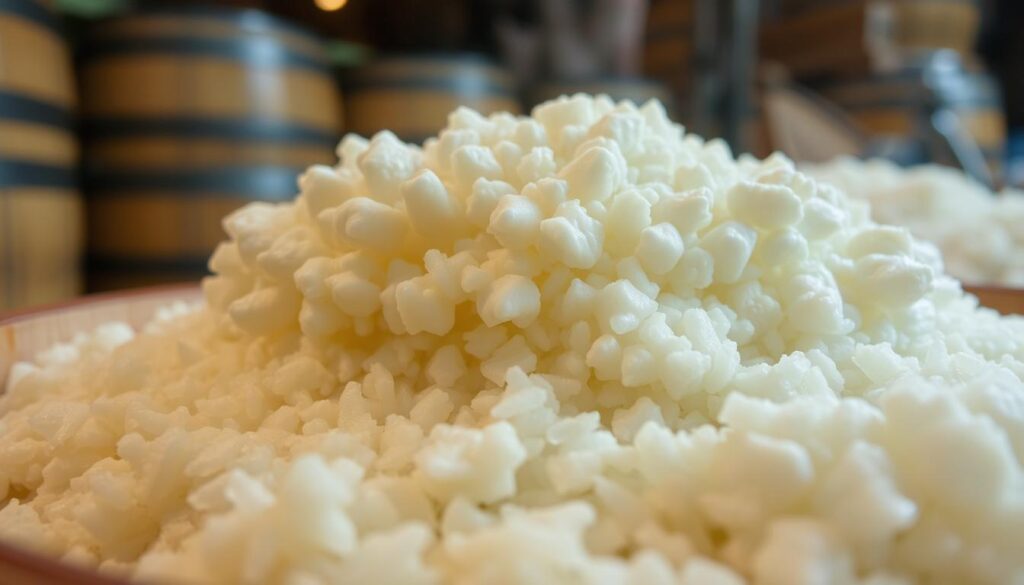
“Only about 1% of the soy sauce produced in Japan is still made in the traditional way using wooden barrels, according to a licensed soy sauce inspector and evaluator.”
Understanding the Basic Ingredients
The heart of Japanese soy sauce is its simple ingredients: soybeans, wheat, salt, and yeast. These elements blend together to make the rich, umami flavor we love in Japanese food.
Soybeans are the main ingredient, chosen for their flavor. The mix of soybeans and wheat can change, with some soy sauces adding fermented rice or amazake for sweetness.
- Artisanal soy sauce often uses whole soybeans for a deeper flavor. But, mass-produced soy sauce might use defatted soy residue for quicker fermentation.
- Wheat, as roasted flour, adds depth and complexity. It’s what gives soy sauce its unique aroma and taste.
- Salt, from the sea, boosts the flavor and helps preserve the soy sauce. It’s key for the fermentation process.
- Yeast starts the fermentation. It turns the ingredients into the rich, umami soy sauce we enjoy.
The mix of these ingredients, along with traditional methods, makes Japanese soy sauce special. From the strong koikuchi to the light usukuchi, each type shows the skill and art in this food staple.
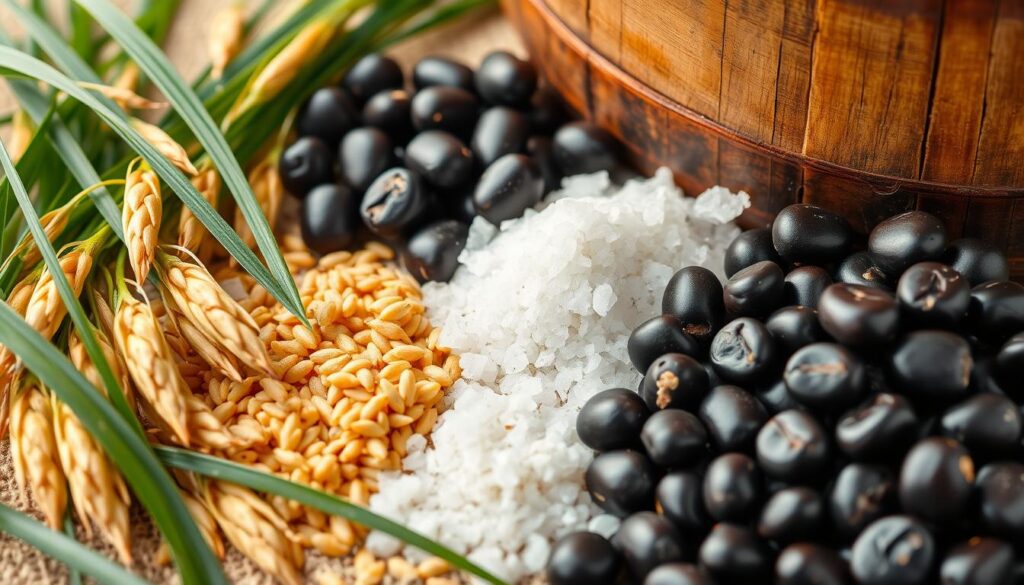
“The essence of Japanese soy sauce lies in its simplicity – a harmonious blend of carefully selected soybeans, wheat, salt, and yeast, each playing a vital role in the creation of this umami-rich elixir.”
The Traditional Fermentation Process
Making authentic Japanese soy sauce is an art that takes centuries to perfect. It starts with growing koji mold, a key ingredient that gives soy sauce its unique flavor.
The process begins with soybeans and wheat, steamed and mixed with Aspergillus oryzae mold. This mold breaks down proteins and carbs, releasing amino acids and enzymes. These elements are what make soy sauce taste so special.
Aging and Maturation
The mixture is then mixed with brine to create moromi. This moromi ferments for months, allowing flavors to grow and mature. As it ages, the alcohol content increases, enhancing the taste.
Quality Control Standards
Quality is key during this time. Producers closely watch the amino acid and alcohol content. They aim for the highest quality. Some use the marudaizu method for even richer flavors.
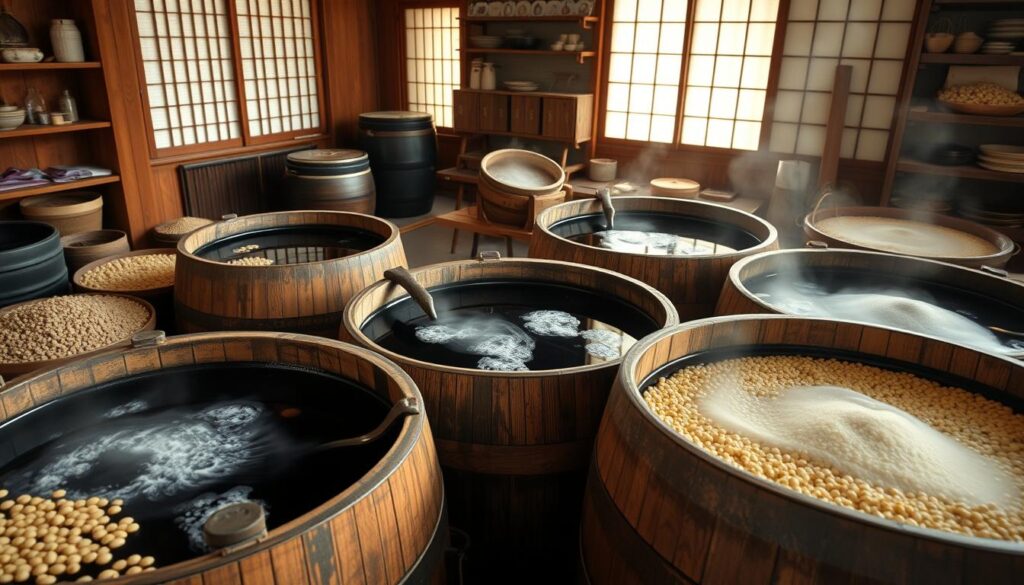
“The fermentation process is the heart and soul of Japanese soy sauce, where time-honored techniques and uncompromising quality come together to create a culinary masterpiece.”
Japanese Soy Sauce Types and Classifications
In the world of Japanese soy sauce, there’s a wide range of types and classifications. Each one caters to different tastes and regional traditions. From the common koikuchi to the light usukuchi and the wheat-free tamari, each has its own flavor and use in Japanese cooking.
Koikuchi soy sauce is the most common, making up 80% of Japan’s soy sauce. It’s dark and rich, adding a deep umami flavor to many dishes. On the other hand, usukuchi soy sauce is lighter and sweeter, favored in western Japan, especially in Kyoto.
Tamari soy sauce is a wheat-free option. It’s thicker and more concentrated, with a bold flavor. It’s mainly made in the Chubu region of Japan.
- Saishikomi soy sauce is a specialty from San-in and Kyushu. It’s made through a special re-brewing process for an intense flavor.
- Shiro soy sauce is the lightest. It comes from the Hekinan district of Aichi prefecture. It’s delicate and versatile.
There are also specialty blends and regional varieties of Japanese soy sauce. These include stock-flavored dashi soy sauces and citrus-infused ponzu. The variety shows Japan’s rich culinary heritage.
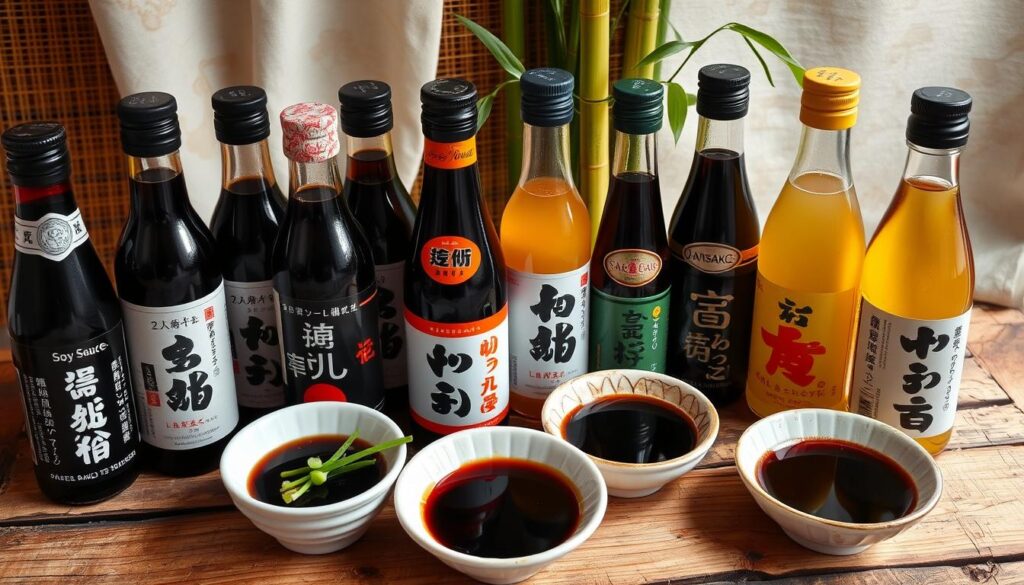
“The depth and complexity of Japanese soy sauce is a reflection of the country’s meticulous attention to tradition and quality.”
Koikuchi: The Most Popular Dark Soy Sauce
Koikuchi is the top choice in Japanese soy sauce, especially in the Kanto region. It has a rich, full-bodied flavor. This makes it great for many dishes.
Flavor Profile and Uses
Koikuchi soy sauce is loved for its deep, complex taste. It’s perfect for marinades, dipping sauces, and seasoning dishes. Its mix of umami, sweetness, and saltiness makes it versatile for both traditional and modern cooking.
Brewing Methods
Making Koikuchi soy sauce takes months. Soybeans and wheat are fermented together in equal parts. This slow process creates its unique flavor and aroma.
“Koikuchi soy sauce is the quintessential Japanese condiment, with a history dating back to the Edo period in the 17th century. Its deep, rich flavor has made it a staple in the Kanto region’s culinary landscape for generations.”
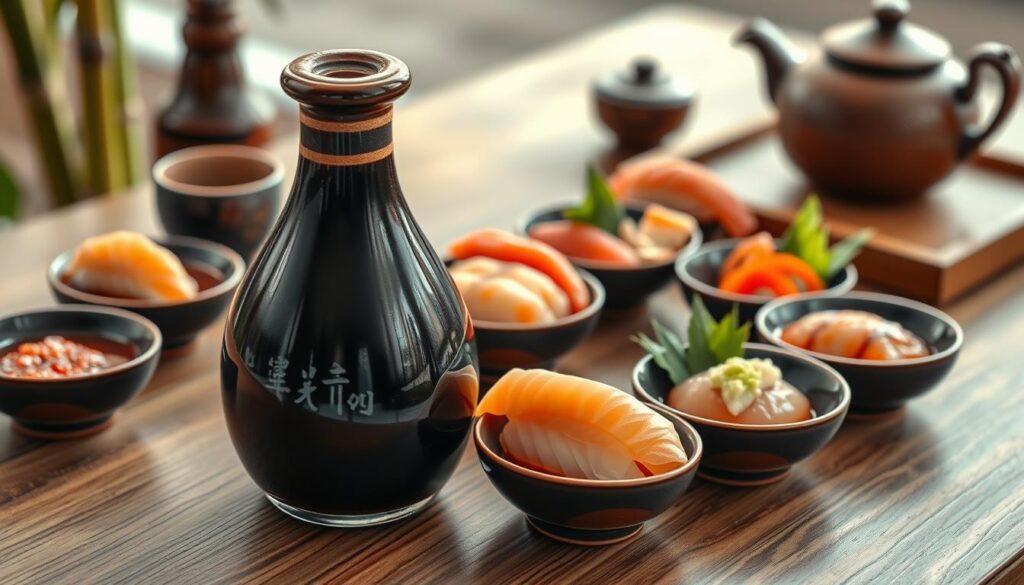
Top brands like Kikkoman and Kamebishi make premium Koikuchi soy sauce. They use traditional methods and quality ingredients. These soy sauces are loved for boosting the taste of many dishes, from classic Japanese to global-inspired ones.
Usukuchi: Light-Colored Premium Sauce
In the world of Japanese soy sauce, Usukuchi is a standout. It’s light in color and has a delicate flavor. This makes it a favorite in the Kansai region, especially in Kyoto.
Usukuchi soy sauce is brewed for about a year. This is less time than Koikuchi, which is aged for two or more years. Despite being lighter, it has a higher salt content, around 18-19%.
The town of Tatsuno in Hyogo Prefecture is famous for Usukuchi soy sauce. It uses high-quality soybeans, wheat, and water from the Ibo River. This makes Usukuchi a key part of Setouchi cuisine and more.
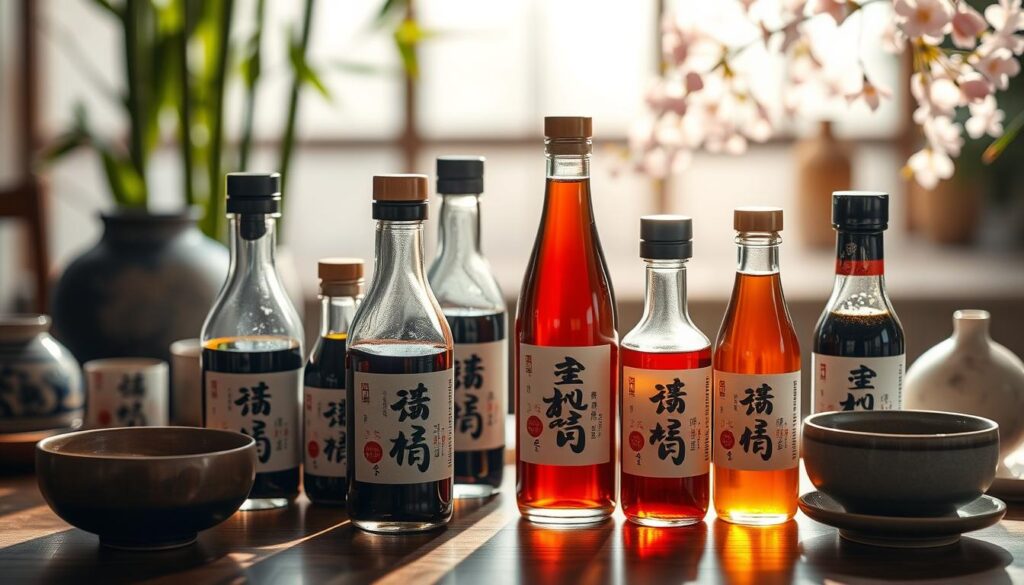
Usukuchi is versatile in cooking. It’s great for dashi stocks, soups, seafood, chicken, pork, tofu, and vegetables. Brands like Suehiro, Teraoka, and Daitoku offer different Usukuchi soy sauces.
Usukuchi Shoyu has a small market share in Japan, about 8%. But its unique taste and regional importance make it special. It’s a premium sauce worth trying, whether you’re exploring Kansai or cooking at home.
Tamari: The Wheat-Free Alternative
Tamari is a standout in Japanese soy sauces. It comes from the Chubu region and has a thick, rich flavor. It’s also gluten-free, making it great for those with dietary needs.
Production Methods
Tamari uses more soybeans than wheat, giving it a deeper flavor. It’s fermented and aged in cedarwood kegs for two summers. This method ensures a smooth, balanced taste.
Culinary Applications
Tamari is very versatile in cooking. It’s often used as a dipping sauce for sashimi and sushi. It also adds a glossy sheen when drizzled over teriyaki or stir-fried vegetables.
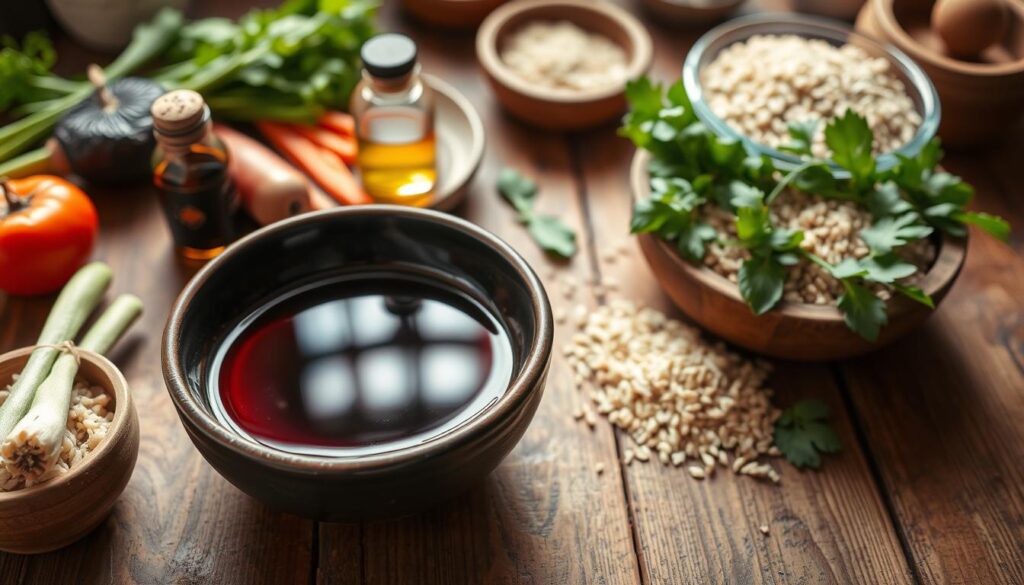
Clearspring Organic Japanese Tamari Soya Sauce is described as double-strength, using twice as many organic whole soya beans as ordinary soy sauces for each bottle, resulting in a smoother and balanced flavor.
Looking for a gluten-free option or a unique soy sauce experience? Tamari is a must-try. Its thick soy sauce character enhances many dishes with its umami notes.
Regional Varieties and Specialties
Japan is known for its rich variety of soy sauce, each with its own story. Saishikomi from Yamaguchi prefecture and shiro shoyu from Aichi prefecture are two standout examples. They show the unique tastes and traditions of their regions.
Saishikomi is made by re-brewing old soy sauce, giving it a darker color and sweeter taste. This method adds a special depth of flavor. In contrast, shiro shoyu is light in color, making it great for enhancing the flavors of light dishes without being too strong.
“These regional specialties reflect the rich tapestry of local culinary traditions that have evolved over centuries, showcasing the diversity and depth of Japanese soy sauce culture.”
Japan also has many other soy sauce types, each with its own unique taste. From the strong tamari to the light usukuchi, the variety shows the creativity of Japanese soy sauce makers.
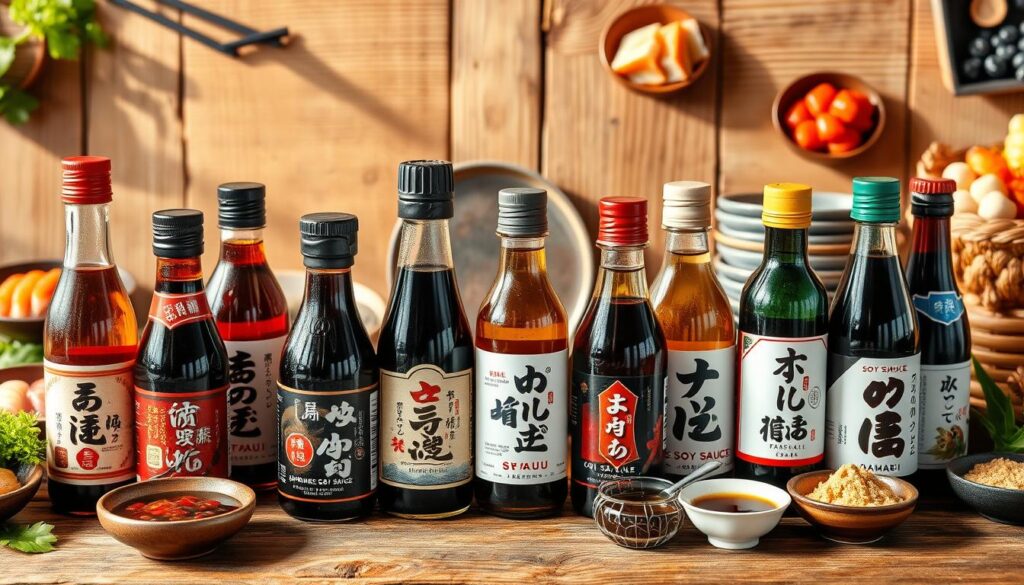
Exploring these regional soy sauces is a journey of flavors through Japan. It lets you discover the rich and varied tastes these special soy sauces offer.
Quality Grades and Standards
Japanese soy sauce is a culinary treasure with strict quality standards. The Japanese government uses the Japanese Agricultural Standard (JAS) to grade soy sauce. It’s divided into three grades: Special Grade, First Grade, and Standard Grade.
These grades are based on several factors. They include amino acid content, alcohol levels, color, aroma, and flavor. Each factor plays a role in determining the soy sauce’s quality.
Government Classifications
The JAS grades are trusted by both consumers and producers. Soy sauces that meet the Special Grade criteria are top-notch. They have a total nitrogen content over 1.50g/100ml and protein levels above 9.38g/100ml.
First Grade soy sauces need at least 1.35g/100ml total nitrogen and 8.44g/100ml protein. Standard Grade soy sauces require a minimum of 1.20g/100ml total nitrogen and 7.50g/100ml protein.
Industry Certifications
Besides JAS grades, the Japanese Soy Sauce Association offers two higher tiers. These are Extra Select and Ultra-Extra Select. These certifications are for soy sauces with outstanding flavor, aroma, and quality.
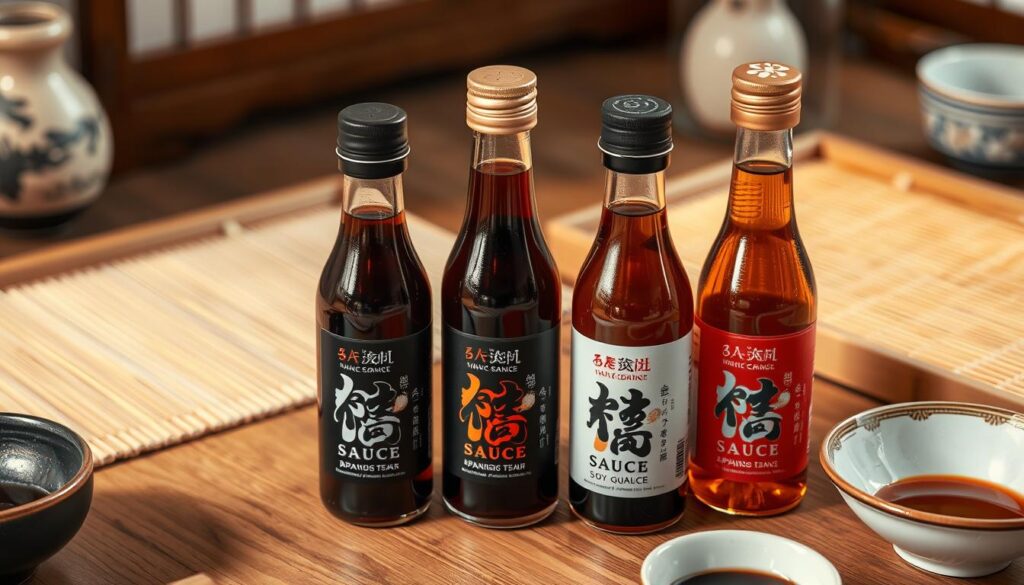
“The quality standards for Japanese soy sauce are a testament to the unwavering commitment to excellence that permeates the industry.”
Health Benefits and Nutritional Value
Soy sauce is known for its deep, savory flavor. It also has health benefits when eaten in small amounts. This traditional Japanese condiment has been a key part of Asian food for over 2,000 years, starting in China.
One tablespoon (16g) of soy sauce has about 879mg of sodium. This is a big part of the daily sodium limit. But, soy sauce also has antioxidants and amhttps://en.wikipedia.org/wiki/Amino_acidino acids. The way it’s made creates over 300 substances, some of which might be good for health.
- Soy sauce is a source of umami, the savory fifth taste. It can make food taste better and might help use less salt.
- Dark soy sauces, like koikuchi shoyu, have more antioxidants. These can protect cells from damage.
- Soy sauce has some amino acids, vitamins, and minerals. But it’s not a big source of these nutrients.
Even with its benefits, soy sauce’s high sodium content means it should be used carefully. For those watching their salt, there are lower-sodium versions. These have 9-13% salt, making them a good choice for health-conscious eaters.
“Soy sauce is a versatile ingredient that can enhance the umami flavor in many dishes, but its high sodium content means it should be used sparingly, especially for those with high blood pressure or other health conditions sensitive to salt intake.”
Soy sauce can be part of a healthy diet, adding flavor to many dishes. But, it’s key to watch how much you use. Choose lower-sodium options to balance the benefits and risks of too much sodium consumption.
Artisanal vs. Commercial Production
In the world of Japanese soy sauce, there’s a big difference between artisanal and commercial methods. Artisanal soy sauce is made with whole soybeans and takes longer to ferment. This makes it taste richer and more complex. Commercial soy sauce, on the other hand, uses soy residue and ferments faster. This results in a less traditional flavor.
Small, family-owned shoyu-ya (soy sauce producers) in Chiba prefecture stick to old ways. They make their soy sauce with care, watching over the fermentation and aging. Big brands like Kikkoman mix old methods with new tech. This lets them keep some traditional flavors while meeting demand.
“Only 1% of soy sauce is produced naturally, brewed in wood barrels. Traditional Oke barrel craftsmen have decreased from 50 houses in Osaka to only 1 in all of Japan.”
Choosing between artisanal and commercial soy sauce affects the taste and quality. Artisanal soy sauce, made with traditional methods, has a deeper, more complex flavor. Mass production methods make the flavor more standard and less unique. If you want the real taste of Japanese soy sauce, look for small-batch, artisanal producers.
Storing and Preserving Japanese Soy Sauce
Keeping Japanese soy sauce in good condition is key. Unopened bottles can sit at room temperature, away from sunlight. But, once you open it, refrigeration is best, especially for nama-shoyu. Soy sauces often have alcohol to keep them fresh longer.
Letting soy sauce breathe can lead to oxidation, which spoils the taste. So, it’s vital to keep the bottle tightly closed. After opening, refrigeration helps keep it fresh for longer.
- Soy sauce is made from soybeans, roasted grain, salt, and a fermenting agent like koji.
- Commercial soy sauces often use sodium benzoate to preserve them.
- The best time to use soy sauce is within three to six months after opening.
- Storing soy sauce in the fridge, even with preservatives, keeps it fresh longer.
For “raw” soy sauce or shoyu, which isn’t pasteurized, refrigeration is crucial after opening. Kikkoman Naturally Brewed Soy Sauce, for instance, has a best-before date on the label or cap, showing its shelf life.
“The sauce can be used for cooking, dipping, marinating, seasoning, or enhancing food flavors. Storing the soy sauce in the fridge after opening helps retain its quality for an extended period of time.”
To keep it at its best, replace the inner plastic cap after each use. Proper care and storage prevent oxidation, which can darken the sauce and reduce its quality.
Pairing with Different Cuisines
Japanese soy sauce is incredibly versatile. It fits well in both traditional and modern dishes. In classic Japanese cooking, it’s key for enhancing sushi, ramen, and teriyaki. Each type of soy sauce, from light usukuchi to strong koikuchi, adds its own special flavor.
Traditional Japanese Dishes
For sushi, light usukuchi soy sauce is best. It balances the fish and rice flavors without overwhelming them. Koikuchi soy sauce, on the other hand, adds a deep, umami flavor to ramen broth. Teriyaki dishes get their sweet and savory glaze from the soy sauce.
Modern Fusion Applications
Japanese soy sauce also shines in international dishes. It adds depth and complexity to many recipes. From salad dressings to fusion sauces, soy sauce’s umami enhances a wide range of flavors.
Its versatility lets it blend into global cuisines. This makes it a global seasoning, beyond its Japanese roots.


